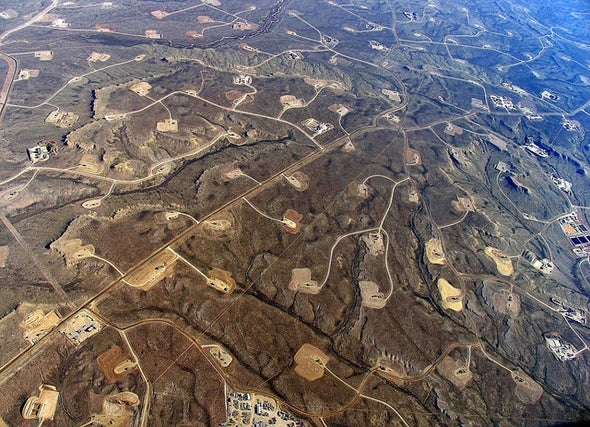How Much Water Does Fracking Use Per Year

Water Use Rises as Fracking Expands
And certain wells use far more water than others, a possible threat in dry regions

Oil and natural gas fracking, on average, uses more than than 28 times the h2o it did 15 years ago, gulping up to nine.6 million gallons of water per well and putting farming and drinking sources at risk in barren states, specially during drought.
Those are the results of a U.S. Geological Survey study published by the American Geophysical Union, the first national-calibration assay and map of h2o employ from hydraulic fracturing operations.
Fracking, which was banned in New York this week because of water pollution and climate concerns, injects large quantities of sand, water and chemicals into the ground at high pressure to release trapped oil and natural gas. The process has been establish to leak large amounts of methyl hydride, a potent greenhouse gas, and the resulting fossil fuels are the primary cause of climate change.
However, the natural gas produced using fracking is frequently considered a more climate-friendly fuel for electricity generation than coal because burning gas emits fewer greenhouse gases.
Though fracking is used to produce natural gas in less-arid regions such every bit Pennsylvania, many of the nation'due south fracking operations occur in places where water may become scarcer in a warming globe, including Texas, the Rocky Mountains and the Great Plains—regions that have been devastated by drought over the last v years.
Energy companies are using more than water to frack oil and gas wells because newer technology, which allows them to find oil in more complicated geology, requires it, USGS research geologist and report co-author Marker Engle said.

The corporeality of water fracking uses is small compared to the water needs of farming or power plant cooling, just in areas that take little water to begin with, fracking can strain water supplies.
"The reality is in that location is a pretty stiff constraint on the amount of fresh water available," he said.
Though some of the water used for fracking is recycled, about of it is disposed deep surreptitious, near entirely removed from the water cycle and never to be used over again.
The study, released Tuesday, looked at h2o consumption used for fracking in all kinds of oil and gas wells, including traditional wells and "unconventional" wells, which usually tap oil and gas found in deep hole-and-corner shale formations which were idea too expensive and impractical to drill until about a decade ago.
The corporeality of water used for fracking in each well varies widely by region. In southern Illinois, an operation tin use as little as two,600 gallons of water each fourth dimension fracking triggers the menses of oil or gas into a well. In Westward Texas' Permian Bowl surrounding Midland and Odessa, fracking uses between 264,000 and 2.six million gallons of water each time. In Pennsylvania, Ohio, south and eastern Texas, Arkansas, northern Colorado and Montana, fracking tin can use more than 9 million gallons of water.
Variations in geology and the specific configuration of an oil and gas well are the biggest factors in how much water fracking consumes, the study's lead author, USGS research engineer Tanya Gallegos, said. Natural gas wells often use more than water than oil wells, particularly gas wells that are horizontally drilled. In a horizontal well, the drill hole runs vertically deep hush-hush, so turns to run roughly parallel to the surface of the earth.
The USGS study shows that some of the regions using the most water for fracking are barren regions, and the corporeality of water each job uses is increasing quickly. Between 2000 and 2014, the average water used to drill a horizontal natural gas well increased from 177,000 gallons to 5.ane 1000000 gallons per well—plenty h2o to fill more than than seven Olympic-sized swimming pools.
Rob Jackson, a Stanford Academy professor of earth organization science who is unaffiliated with the report, said the USGS research is more comprehensive than other studies nigh the water needs of fracking and clearly shows the spiking water intensity of oil and gas drilling and fracking.
"The h2o utilise for horizontal oil and gas drilling has doubled in the past 5 years per well," he said. "In wet regions like the Marcellus (in Pennsylvania), I don't think water use is that large a deal. In dry out areas it can be a big deal. The strongest effects come through increased pumping of groundwater."
Fracking can increment demand for groundwater by up to 30 pct in some arid regions, he said. "So, I call back in barren counties, for groundwater consumption, this can be a major increase."
This commodity is reproduced with permission from Climate Cardinal. The article was start published on July 1, 2015.
How Much Water Does Fracking Use Per Year,
Source: https://www.scientificamerican.com/article/water-use-rises-as-fracking-expands/
Posted by: rossarishe.blogspot.com


0 Response to "How Much Water Does Fracking Use Per Year"
Post a Comment